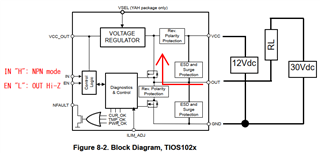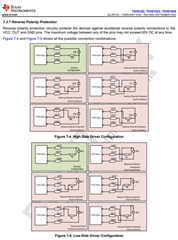Tool/software:

If the RL connected to the OUT terminal has a voltage higher than the device's power supply, will current flow through the FET diode?
This thread has been locked.
If you have a related question, please click the "Ask a related question" button in the top right corner. The newly created question will be automatically linked to this question.
Tool/software:

If the RL connected to the OUT terminal has a voltage higher than the device's power supply, will current flow through the FET diode?
The TIOS1025 uses an active monitoring circuit that protects the device from a reverse polarity protection (i.e. mis-wiring) scenario as identified in the datasheet.

If the voltage on the OUT pin is at least 50mV greater than the VCC pin voltage, the driver FETs will be disabled.
When the driver is enabled, the OUT pin and VCC pin are connected with a very low impedance that comes from the RDS(on) of the FET which is between 2.5 and 4.5ohms.
When you intentionally pull up the OUT to a higher voltage than what is used on the VCC pin, then the higher voltage can flow through the FET and effectively replace the VCC supply until there is enough current flowing across the FET (and RDS(on) to create a 50mV difference between the OUT and VCC pins to disable the driver.
If the Rload is connected to the same supply voltage as shown in the datasheet protection figures, a voltage difference is easily detected and the driver is disabled right away.
Regards,
Jonathan